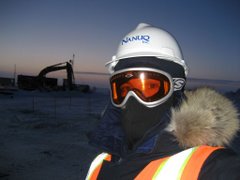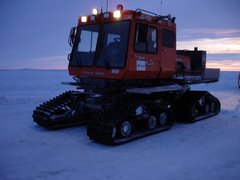So it seems that my many travel updates have given the impression that I’ve been on vacation the entire summer. This is not entirely untrue since I know I’ve had a lot of fun but, I also spent a good deal of time participating in research at the DPRI. A brief summary of the work I performed follows.
In a nut shell the purpose of my efforts at the DPRI geomechanics division was to generate experimental data for comparison to and validation of the numerical modeling results of a computer code developed by Dr. Susumu Iai. The code is called FLIP, is based on the finite element method, and is used for the 2D analysis of lateral pile deflection in soil. The basic output of concern for this program are vector displacement fields corresponding to the nodes of the finite element mesh used to define the soil surrounding the pile. Two cases were considered for a model pile displacing through soil; drained and undrained. The drained condition was the first and easiest case tackled followed by the somewhat more difficult undrained testing.The basic test setup consisted of an aluminum test bed having inner dimensions of 80 cm by 50 cm by 4 cm depth. The model pile was fabricated from Teflon, has dimensions of 5 cm diameter by 4.2 cm height, and was constructed in a modular fashion with intermediate compressible gasket to allow for intimate and continuous contact between the pile top and acrylic cover bottom. The acrylic cover was attached to the test bed with a series of perimeter bolts and gasket between the cover and test bed wall. The model pile was attached by wirerope to a lateral load mechanism via an opening at one end of the test bed fit with a tight bushing.
The information I’ve listed above describes the extent of fabrication work Iai-sensei and Tobita-san had completed prior to my arrival. The methodology to be employed for generation of experimental vector displacement fields was left up to me and is to be the foundation for the remaining three years of research left for this program. At the end of the summer I passed on all the test methods and data that I had developed to Iai-sensei and specifically to the ever estute and diligent Mr. Keita Yamaguchi who was recently accepted for masters work at the DPRI. A brief description of the general test method for each condition is given below.
For the drained or dry condition a hopper was employed to “drop” silica sand into the test bed. The sand was then smoothed by hand using a system of aluminum tracks and a 100 cm aluminum ruler. A plastic frame was then employed to place a red dyed silica sand grid around the model pile. The pile was latterly displaced via the load mechanism with motions recorded by digital still photography and video tape. The gathered visual data was then used to track the nodes of the red sand grid and draw displacement vectors using the Surfer software package. A similar process was repeated using a x25 microscope to record the motion of the pile. In this instance, due to the extreme magnification, the red sand grid was replaced with randomly sprinkled red colored sand. This data was again processed with the Surfer program to obtain a vector displacement field.
For the undrained condition silica sand was mixed with a series of liquids. Problems initially arosefrom settling of the sand resulting in increased pore water pressure and “bleeding” to the top of the sand layer. This had the effect of washing away the red sand dots used to track soil displacement and obscuring the pile top from recording equipment. This problem was solved by testing different mixtures of water and a cellulose base compound called Metlose to increase the viscosity of the liquid used to mix the silica sand slurry. The best results were obtained with a liquid mixture having 120 times the viscosity of water. The same recording and processing techniques used for the drained condition were then used to obtain vector displacement fields.
The photos and figures below are of the general test set-up and some test results. Links are also provided to the very rough but much more detailed draft paper I wrote for publication in a Japanese journal covering geotechnical experimental methods (it's in the format required for the JSPS report) as well as the report I had to submit for the initial NHMJ program.
Well, if you’ve read all the way to the end then you are either a geotechnical engineer or you weren’t sleepy enough to get bored. I hope you enjoyed reading all of that gobledy-gook and please drop me a line if you have any questions or comments. Thanks.
Matt

Empty Testbed, DPRI of Kyoto University, Japan, Summer 2003

Model Teflon Pile, DRPI of Kyoto University, Japan, Summer 2003

Complete Set-up Ready for Testing, DPRI of Kyoto University, Japan, Summer 2003

Overall displacement field for drained case, DPRI of Kyoto University, Japan, Summer 2003

Local displacement field for drained case, DPRI of Kyoto University, Japan, Summer 2003



No comments:
Post a Comment